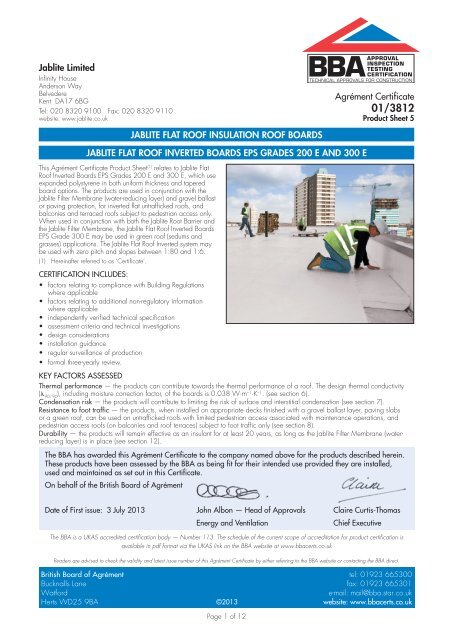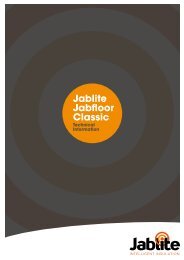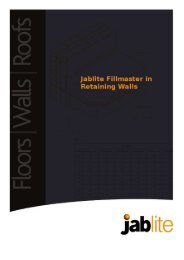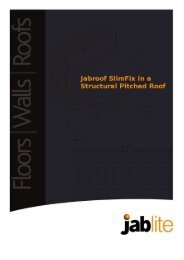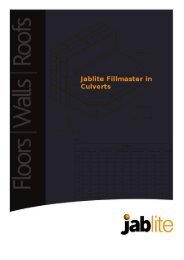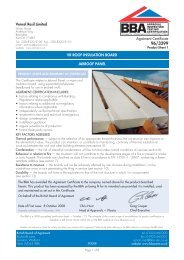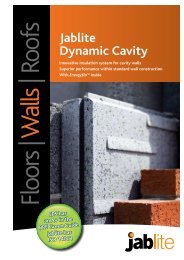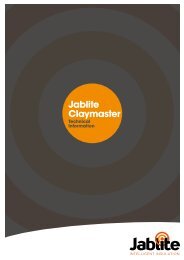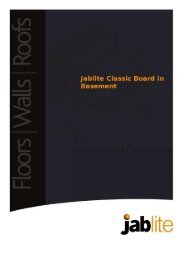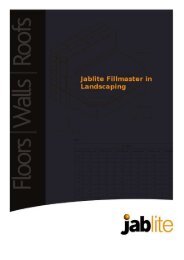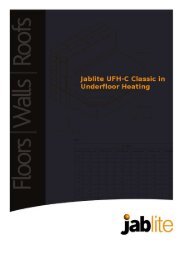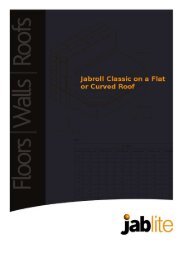Jablite Flat Roof Inverted Boards EPS Grades 200 E and 300 E
Jablite Flat Roof Inverted Boards EPS Grades 200 E and 300 E
Jablite Flat Roof Inverted Boards EPS Grades 200 E and 300 E
Create successful ePaper yourself
Turn your PDF publications into a flip-book with our unique Google optimized e-Paper software.
Figure 2 Typical installation detail — gravel/paving ballast finishFigure 3 Typical installation detail — green roof finish4.10 Concrete, metal or timber roofs should be designed in accordance with the relevant provisions ofBS 6229 : <strong>200</strong>3, BS 8217 : <strong>200</strong>5 <strong>and</strong> BS 8218 : 1998, in particular to accommodate the weight of the ballastlayer.4.11 Decks should be covered with one or more of the following roof waterproofing specifications:• built-up felt roofing to BS 8217 : <strong>200</strong>5 using Type 3 <strong>and</strong> Type 5 felts to BS 8747 : <strong>200</strong>7• mastic asphalt laid in accordance with BS 8218 : 1998• other waterproofing systems which are the subject of a current Agrément Certificate, laid in accordance with, <strong>and</strong>within the limitations imposed by, that Certificate.4.12 The roof shall be designed with adequate falls unless the roof waterproofing system has been specificallydesigned <strong>and</strong> approved for use in a zero pitch roof application. For zero pitch roofs it is particularly important toidentify the correct drainage points, to ensure that the drainage provided is sufficient <strong>and</strong> effective.4.13 It is essential that roof falls <strong>and</strong> drainage paths are correctly designed to avoid ponding <strong>and</strong> subsequent riskof silt build up, stresses in freezing conditions <strong>and</strong> to reduce water entry in the event of a failure in the waterproofinglayer.4.14 Tapered insulation boards may be used where appropriate, to achieve the minimum finished falls required. Anyexisting irregularities in the roof should be overcome before a tapered system is laid.4.15 Dual level roof drainage should be provided in accordance with BS 6299 : <strong>200</strong>3 <strong>and</strong>BS EN 12056-3 : <strong>200</strong>0 to drain water off at the level of the <strong>Jablite</strong> Filter Membrane <strong>and</strong> also at the level of the roofwaterproofing. See Figures 6 to 8.4.16 Drainage points need to be located at the lowest point of the roof, to facilitate the effective removal ofrainwater. Care is needed to identify these locations. For example, precast concrete decks will deflect between spans,<strong>and</strong> mid-span may be the lowest point of the roof rather than roof edges or column supports.4.17 Where there is a risk from plasticiser migration or other contaminants from the roof waterproofing (such asPVC single ply membranes) a suitable plastic fibre or similar isolating sheet must be interposed between the roofwaterproofing <strong>and</strong> the <strong>EPS</strong> insulation boards. For loose laid single layer roof waterproofing membranes, a cushionlayer should be interposed.5 Practicability of installationThe products are designed to be installed by a competent general builder or contractor experienced with these types ofproducts.Page 6 of 12
6 Thermal performance6.1 Calculations of the thermal transmittance (U value) of a specific roof construction should be carried out inaccordance with BS EN ISO 6946 : <strong>200</strong>7 <strong>and</strong> BRE Report BR 443 : <strong>200</strong>6, using the design thermalconductivity (included moisture correction factor) <strong>and</strong> f xdrainage factor for the system as given below. See alsoBBA Information Bulletin No 4• 0.038 W·m –1·K–1 — design thermal conductivity ( U) (including moisture correction factor) for <strong>EPS</strong> <strong>200</strong> E <strong>and</strong><strong>EPS</strong> <strong>300</strong> E• f x= 0.001 — drainage factor for systems incorporating the <strong>Jablite</strong> Filter Membrane.The value of a completed roof will depend on the insulation thickness, <strong>and</strong> type of substrate <strong>and</strong> internal finish. Whenconsidering insulation requirements, designers should refer to the detailed guidance contained in the documentssupporting the national Building Regulations. The U values shown in Table 4 indicate that the product can contribute toa roof achieving typical U values referred to in those supporting documents.Table 4 Example U values (2) for flat roof <strong>and</strong> zero pitch applications(incorporating the <strong>Jablite</strong> Filter Membrane)RequiredU Value(W·m -2·K -1 )<strong>EPS</strong> <strong>200</strong> E <strong>and</strong> <strong>300</strong> EInsulation thickness required (3) (mm)p (1) 3 p (1) = 80.13 140 + 135 190 + 1000.15 240 2500.16 225 2350.18 <strong>200</strong> 2100.20 180 1850.25 145 145(1) Values for p taken as examples of best to worst case for all UK locations.(2) <strong>200</strong> mm dense concrete deck with 3 mm plaster skim.(3) Thickest board as bottom layer, when double layer used.6.2 Rainfall reaching the roof waterproofing membrane will temporarily affect the rate of heat loss from the roof <strong>and</strong>should be accounted for by adding a correction (U r) to the calculated roof U value in accordance with Annex D.4 ofBS EN ISO 6946 : <strong>200</strong>7, as follows:U r= pfx (R 1/R T) 2 where:U r= correction to the calculated thermal transmittance of the roof element (W·m –2·K–1 ).p (1) = average rate of precipitation during the heating season (mm·day –1 ).f = drainage factor giving the fraction of p reaching the waterproof membrane.x = factor for increased heat loss caused by rainwater flowing on the membrane (W·day·m –2·K–1·mm–1 ).R 1= thermal resistance of the layer of the insulation above the waterproofing membrane (m 2·K·W –1 ).R T= total thermal resistance of the construction before application of the correction (m 2·K·W –1 ).f x= 0.001 for the system incorporating the <strong>Jablite</strong> Filter Membrane (water reducing layer).(1) values for average rainfall during the heating season for different UK locations can be found at www.metoffice.gov.uk/climate/uk/averages/19611990/images/RainOctMar6190.gif <strong>and</strong> divided by 182 days to obtain ‘p’ in mm·day –1 .6.3 The products can contribute to maintaining continuity of thermal insulation at junctions. For AccreditedConstruction Details, the corresponding psi values in BRE Information Paper IP 1/06, Table 3, may be used incarbon emission calculations in Scotl<strong>and</strong> <strong>and</strong> Northern Irel<strong>and</strong>. Detailed guidance for other junctions <strong>and</strong> onlimiting heat loss by air infiltration can be found in:Engl<strong>and</strong> <strong>and</strong> Wales — Approved Documents to Part L <strong>and</strong> for new thermal elements to existing buildings, AccreditedConstruction Details (version 1.0). See also SAP <strong>200</strong>9 Appendix K <strong>and</strong> the iSBEM User Manual for new-buildScotl<strong>and</strong> — Accredited Construction Details (Scotl<strong>and</strong>)Northern Irel<strong>and</strong> — Accredited Construction Details (version 1.0).7 Condensation risk7.1 Warm water trapped under the boards is likely to be replaced by colder water during rainfall. Therefore, duringheavy or continuous rainfall the roof waterproofing <strong>and</strong> the deck will be cooled. If condensation does occur it will beshort-term, disappearing when the rain stops.7.2 Risk of interstitial condensation will be minimal with concrete decks but metal <strong>and</strong> timber decks will be subjected to shortperiods of moisture; therefore timber must be treated with a suitable preservative in accordance with BS 8417 : 2011.7.3 For systems using paving or a green roof finish, a condensation risk analysis may be necessary using dynamicsoftware in accordance with BS EN 15026 : <strong>200</strong>7, depending on the climatic conditions existing in the locationwhere it is installed.Page 7 of 12
Interstitial condensation7.4 <strong>Roof</strong>s will adequately limit the risk of interstitial condensation when they are designed <strong>and</strong> constructed inaccordance with BS 5250 : 2011, Section 4 <strong>and</strong> Annex D <strong>and</strong> H.Surface condensation7.5 <strong>Roof</strong>s will adequately limit the risk of surface condensation when the thermal transmittance (U value) doesnot exceed 0.35 W·m –2·K–1 at any point <strong>and</strong> the junctions with walls are designed in accordance with therelevant requirements of Limiting thermal bridging <strong>and</strong> air leakage : Robust construction details for dwellings <strong>and</strong>similar buildings, TSO <strong>200</strong>2, or BRE Information Paper IP 1/06.7.6 <strong>Roof</strong>s will adequately limit the risk of surface condensation when the thermal transmittance (U value) doesnot exceed 1.2 W·m –2·K –1 at any point. Guidance may by obtained from BS 5250 : 2011, Section 4, <strong>and</strong>BRE Report BR 262 : <strong>200</strong>2.8 Resistance to foot trafficThe <strong>Jablite</strong> <strong>Flat</strong> <strong>Roof</strong> <strong>Inverted</strong> <strong>Boards</strong> <strong>EPS</strong> <strong>Grades</strong> <strong>200</strong> E <strong>and</strong> <strong>300</strong> E have adequate resistance to the loads associatedwith light maintenance traffic on roofs, <strong>and</strong> to pedestrian foot traffic on balconies <strong>and</strong> roof terraces.9 Behaviour in relation to fire9.1 <strong>Jablite</strong> <strong>Flat</strong> <strong>Roof</strong> <strong>Inverted</strong> <strong>Boards</strong> <strong>EPS</strong> <strong>Grades</strong> <strong>200</strong> E <strong>and</strong> <strong>300</strong> E used in the inverted roof concept have a Class Ereaction to fire classification to BS EN 13501-1 : <strong>200</strong>7 <strong>and</strong> are ballasted with either aggregate (minimum depth of50 mm), s<strong>and</strong>/cement screed to a thickness of at least 30 mm, or fully supported cast stone or mineral slabs of at least40 mm thickness. Therefore the roof may be considered to be of designation AA (low vulnerability in Scotl<strong>and</strong>) <strong>and</strong>meets or satisfies the requirements of the national Building Regulations, thus:Engl<strong>and</strong> <strong>and</strong> Wales — Requirement B4(2)Scotl<strong>and</strong> — M<strong>and</strong>atory St<strong>and</strong>ard 2.8, clause 2.8.1 (1)(2)(1) Technical H<strong>and</strong>book (Domestic).(2) Technical H<strong>and</strong>book (Non-Domestic)Northern Irel<strong>and</strong> — Regulation 36(b).9.2 The designation of other roof covering specifications should be confirmed as required by the national BuildingRegulations.9.3 The <strong>Jablite</strong> <strong>Flat</strong> <strong>Roof</strong> <strong>Inverted</strong> insulation boards should not be laid over compartment walls.10 Effect on roof coveringsThe protected inverted roof system will provide solar protection <strong>and</strong> also limit the range of temperatures to which thewaterproofing membrane will be subjected. Placing the insulation on top of the roof covering will normally lead to anextended life of the waterproof membrane.11 Maintenance11.1 The inverted roof concept should require little or no maintenance, other than annual removal of any plants(in the case of gravel/paving finish), cleaning/checking of water outlets <strong>and</strong> gutters if necessary <strong>and</strong> checkingthat the gravel ballast is still in place <strong>and</strong> not interfering with or blocking gullies or outlets. Any displaced ballast,for example by wind scouring, should be promptly returned to its original state.11.2 The use of chemicals (eg weed killers) should be checked for compatibility with the insulation, <strong>Jablite</strong> FilterMembrane <strong>and</strong> the deck waterproofing layer. The Certificate holder can advise on the suitability of a particularproduct.11.3 Leaks in the waterproof membrane can be accessed by removal of the gravel ballast, paving or green roofcovering, <strong>Jablite</strong> Root Barrier (green roofs only), <strong>Jablite</strong> Filter Membrane <strong>and</strong> insulation boards, taking care not todamage the water-reducing layer.11.4 Protected inverted roofs can be upgraded by the addition of insulation so long as there is sufficient height in theparapets <strong>and</strong> roof lights. This may also require additional ballast, therefore the structural deck must be adequate tosupport the extra loading from the increase in weight.11.5 The Certificate holder must approve any upgrading using a loose layer of insulation on top of the existinginsulation.12 Durability12.1 The <strong>Jablite</strong> <strong>Flat</strong> <strong>Roof</strong> <strong>Inverted</strong> <strong>Boards</strong> <strong>EPS</strong> <strong>Grades</strong> <strong>200</strong> E <strong>and</strong> <strong>300</strong> E are rot resistant <strong>and</strong>, as long as the<strong>Jablite</strong> Filter Membrane remains undamaged, will have a life of at least 20 years under normal circumstances.12.2 Care must be taken to ensure that the gravel ballast, or paving/green roof covering once installed, providescover to the <strong>Jablite</strong> Filter Membrane at all times to avoid UV degradation of the membrane.Page 8 of 12
13 Reuse <strong>and</strong> recyclability<strong>Jablite</strong> <strong>Flat</strong> <strong>Roof</strong> <strong>Inverted</strong> <strong>EPS</strong> insulation boards are fully recyclable.Installation14 General14.1 <strong>Jablite</strong> <strong>Flat</strong> <strong>Roof</strong> <strong>Inverted</strong> <strong>Boards</strong> <strong>EPS</strong> <strong>Grades</strong> <strong>200</strong> E <strong>and</strong> <strong>300</strong> E are laid over a compatible <strong>and</strong> completewaterproofing system (see section 4.11), generally starting at the point of access in a brick bond pattern.14.2 The <strong>Jablite</strong> <strong>Flat</strong> <strong>Roof</strong> <strong>Inverted</strong> insulation boards must be laid flat <strong>and</strong> tightly interlocked to prevent gaps in theinsulation layer. Insulation boards are laid in an advancing front, with the <strong>Jablite</strong> Filter Membrane (water-reducing layer)on top, <strong>and</strong> the ballast, paving or green roof covering laid as soon as possible to protect the system.14.3 Where necessary, boards are cut accurately with a fine tooth saw or with a hot wire cutter around anypenetrations.14.4 The <strong>Jablite</strong> Filter Membrane is laid with <strong>300</strong> mm unsealed laps overlapping in the downward direction of the flatroof slope, immediately on top of the insulation boards. At upst<strong>and</strong>s <strong>and</strong> penetrations the <strong>Jablite</strong> Filter Membrane mustbe turned up to finish above the surface of the ballast layer <strong>and</strong> turned down at drainage outlets. See Figures 4 to 8.Figure 4 Parapet upst<strong>and</strong> detail — gravel/paving finishFigure 5 Parapet upst<strong>and</strong> detail — green roof finishPage 9 of 12
Figure 6 Water outlet detail — gravel finishFigure 7 Water outlet detail — paving finishFigure 8 Water outlet detail — green roof finishProcedureGravel ballast finish14.5 In order to prevent flotation, wind uplift <strong>and</strong> UV degradation, the system must be covered with gravel ballast asthe work proceeds, to a minimum thickness of 50 mm.14.6 It is essential that the ballast is carefully placed directly over the <strong>Jablite</strong> Filter Membrane laid with <strong>300</strong> mmunsealed lap joints, <strong>and</strong> that complete depth <strong>and</strong> cover is achieved over the entire surface of the system.14.7 Gravel must not contain excessive fines in order to prevent clogging of gullies <strong>and</strong> outlets <strong>and</strong> to discourageorganic growth.Paving slab finish14.8 Cast stone or mineral slab pavings of at least 40 mm thickness, must meet the requirements of sections 7.3 <strong>and</strong>9 of this Certificate. Paving slabs can either be laid fully supported, or may be supported using proprietary spacerpads in accordance with the manufacturer’s instructions.14.9 The paving slab finish is laid directly over the <strong>Jablite</strong> Filter Membrane laid with <strong>300</strong> mm unsealed lap joints.Green <strong>Roof</strong> Finish14.10 The <strong>Jablite</strong> Root Barrier is to be installed directly on top of the <strong>Jablite</strong> Filter Membrane. <strong>Jablite</strong> Root Barrier Tapeis used to seal <strong>300</strong> mm laps in the <strong>Jablite</strong> Root Barrier, in accordance with the manufacturer’s instructions.14.11 The green roof system including growing medium, geotextile filter fleece, <strong>and</strong> water retention/drainage layeretc is to be installed in accordance with the manufacturer’s instructions, on top of the <strong>Jablite</strong> Root Barrier.14.12 All upst<strong>and</strong>s, roof perimeters, drainage outlets <strong>and</strong> other protrusions through the green roof, should beprotected by a minimum 500 mm wide un-vegetated barrier such as 20 mm to 40 mm rounded gravel aggregate orconcrete paving slabs.Page 10 of 12
Tapered boards14.13 Pre-moulded boards tapered to required falls are pre-labelled to the requirements of the specific building, asnoted on the Certificate holder’s roof layout drawing.14.14 To provide a uniform fall it is essential that the deck is even <strong>and</strong> true. Any irregularities such as hollows,backfalls, or depressions must be levelled prior to laying the boards.14.15 <strong>Boards</strong> are laid directly on top of the <strong>Jablite</strong> Filter Membrane sequentially in accordance with the position codenumber/letter on the roof layout drawing. Laying of the tapered insulation should commence at points indicated on thelayout drawing.14.16 The tapered boards are carefully ballasted as soon as possible to protect the system.Technical Investigations15 TestsTests were carried out by the BBA on <strong>Jablite</strong> <strong>Flat</strong> <strong>Roof</strong> <strong>Inverted</strong> <strong>Boards</strong> <strong>EPS</strong> <strong>Grades</strong> <strong>200</strong> E <strong>and</strong> <strong>300</strong> E <strong>and</strong> the resultsassessed to determine:• thermal conductivity• compressive strength• water flow through an inverted roof kit• bending strength• dimensional stability• water vapour permeability• deformation under specified compressive load <strong>and</strong> temperature• long-term water absorption by diffusion• resistance to freeze-thaw of the thermal insulation• moisture conversion coefficient of the thermal conductivity of the insulation.16 Investigations16.1 Independent data relating to the following were examined:• thermal conductivity• moisture correction.16.2 An on-site investigation was carried out at two existing flat-roofed buildings, to examine the effects of root growth(from a green roof finish) on the <strong>Jablite</strong> <strong>Flat</strong> <strong>Roof</strong> <strong>Inverted</strong> system.16.3 The manufacturing process <strong>and</strong> quality control procedures were evaluated <strong>and</strong> details obtained of the quality<strong>and</strong> composition of materials used.BibliographyBS 5250 : 2011 Code of practice for control of condensation in buildingsBS 6229 : <strong>200</strong>3 <strong>Flat</strong> roofs with continuously supported coverings — Code of practiceBS 8217 : <strong>200</strong>5 Reinforced bitumen membranes for roofing — Code of practiceBS 8218 : 1998 Code of practice for mastic asphalt roofingBS 8417 : 2011 Preservation of wood — Code of practiceBS 8747 : <strong>200</strong>7 Reinforced bitumen membranes (RBMs) for roofing — Guide to selection <strong>and</strong> specificationBS EN 1991-1-2 : <strong>200</strong>2 Eurocode 2 : Design of concrete structures — General rules — Structural fire designBS EN 1991-1-4 : <strong>200</strong>5 Eurocode 1 — Actions on structures — General actions — Wind actionsNA to BS EN 1991-1-4 : <strong>200</strong>5 UK National Annex to Eurocode 1 : Actions on structures — General actions —Wind actionsBS EN 12056-3 : <strong>200</strong>0 Gravity drainage systems inside buildings — <strong>Roof</strong> drainage, layout <strong>and</strong> calculationBS EN 13501-1 : <strong>200</strong>7 Fire classification of construction products <strong>and</strong> building elements —Classification using testdata from reaction to fire testsBS EN 15026 : <strong>200</strong>7 Hygrothermal performance of building components <strong>and</strong> building elements — Assessment ofmoisture transfer by numerical simulationBS EN ISO 6946 : <strong>200</strong>7 Building components <strong>and</strong> building elements — Thermal resistance <strong>and</strong> thermal transmittance— Calculation methodBS EN ISO 9001 : <strong>200</strong>8 Quality management systems — RequirementsBS EN ISO 14001 : <strong>200</strong>4 Environmental management systems — Requirements with guidance for useBRE Information Paper IP 1/06 Assessing the effects of thermal bridging at junctions <strong>and</strong> around openingsPage 11 of 12
BRE Report BR 262 : <strong>200</strong>2 Thermal insulation: avoiding risksBRE Report BR 443 : <strong>200</strong>6 Conventions for U-value calculationsThe Green <strong>Roof</strong> GuideConditions of Certification17 Conditions17.1 This Certificate:• relates only to the product/system that is named <strong>and</strong> described on the front page• is issued only to the company, firm, organisation or person named on the front page — no other company, firm,organisation or person may hold or claim that this Certificate has been issued to them• is valid only within the UK• has to be read, considered <strong>and</strong> used as a whole document — it may be misleading <strong>and</strong> will be incomplete to beselective• is copyright of the BBA• is subject to English Law.17.2 Publications, documents, specifications, legislation, regulations, st<strong>and</strong>ards <strong>and</strong> the like referenced in this Certificateare those that were current <strong>and</strong>/or deemed relevant by the BBA at the date of issue or reissue of this Certificate.17.3 This Certificate will remain valid for an unlimited period provided that the product/system <strong>and</strong> its manufacture<strong>and</strong>/or fabrication, including all related <strong>and</strong> relevant parts <strong>and</strong> processes thereof:• are maintained at or above the levels which have been assessed <strong>and</strong> found to be satisfactory by the BBA• continue to be checked as <strong>and</strong> when deemed appropriate by the BBA under arrangements that it will determine• are reviewed by the BBA as <strong>and</strong> when it considers appropriate.17.4 The BBA has used due skill, care <strong>and</strong> diligence in preparing this Certificate, but no warranty is provided.17.5 In issuing this Certificate, the BBA is not responsible <strong>and</strong> is excluded from any liability to any company, firm,organisation or person, for any matters arising directly or indirectly from:• the presence or absence of any patent, intellectual property or similar rights subsisting in the product/system or anyother product/system• the right of the Certificate holder to manufacture, supply, install, maintain or market the product/system• actual installations of the product/system, including their nature, design, methods, performance, workmanship <strong>and</strong>maintenance• any works <strong>and</strong> constructions in which the product/system is installed, including their nature, design, methods,performance, workmanship <strong>and</strong> maintenance• any loss or damage, including personal injury, howsoever caused by the product/system, including its manufacture,supply, installation, use, maintenance <strong>and</strong> removal• any claims by the manufacturer relating to CE marking.17.6 Any information relating to the manufacture, supply, installation, use, maintenance <strong>and</strong> removal of this product/system which is contained or referred to in this Certificate is the minimum required to be met when the product/systemis manufactured, supplied, installed, used, maintained <strong>and</strong> removed. It does not purport in any way to restate therequirements of the Health <strong>and</strong> Safety at Work etc. Act 1974, or of any other statutory, common law or other dutywhich may exist at the date of issue or reissue of this Certificate; nor is conformity with such information to be taken assatisfying the requirements of the 1974 Act or of any statutory, common law or other duty of care.British Board of Agrément tel: 01923 665<strong>300</strong>Bucknalls Lane fax: 01923 665301Watforde-mail: mail@bba.star.co.ukHerts WD25 9BA©2013website: www.bbacerts.co.ukPage 12 of 12


